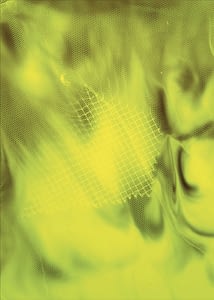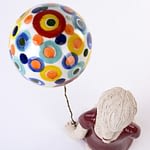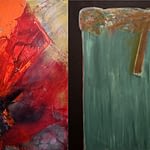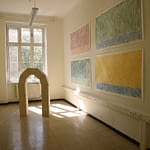
Josef Ramaseder – spopredust paintings
At first glance, Josef Ramaseder’s pictures seem like photograms. Quite similar to those created by the Dada artist Man Ray under the name “Rayografien”. In contrast to Man Ray, however, Ramaseder’s “spopredust paintings” are not created in the darkroom but in a daylight studio.
In contrast to photograms in which exposed and subsequently developed AgBr crystals produce the black/white effect, Ramaseder’s spores of mushrooms make the compositions on the sometimes monochrome-colored supports appear in a light brown shade on one occasion and in a darker brown shade on another – depending on the type of mushroom used.
Ramaseder’s graphics are created by placing kilograms of mushrooms on specially made “scattering boxes”. As the spores detach from the mushrooms over time and fall onto the underlying carrier material (paper or canvas), the latter virtually draw the picture. For this reason, one can also call these “Ramasedergrafien” mycograms, derived from “mýkes”, the ancient Greek word for mushroom.
Ramaseder’s mycograms appear partly abstract and partly very sharp, due on the one hand to the different drop heights of the spores and on the other hand to the spatial position of the objects depicted.
Ramaseder’s mycograms bear witness to the artist’s different fields of activity. In some of his works Ramaseder pursues formal questions, such as basic forms or grid structures. In other mycograms, on the other hand, objects sometimes even find their way into Ramaseder’s pictorial inventions with people from his personal surroundings.
Ramaseder’s way of working is very spontaneous and intuitive. It is only after a certain period of time has elapsed that the artist subjects his works to a critical analysis.
Josef Ramaseder does not belong to that group of artists who claim to have reinvented the wheel, and that makes him quite sympathetic, but at least formally sees parallels to other artists of his and past generations. One of them is the German sculptor Wolfgang Laib (*1950) and his occupation with pollen. However, Ramaseder associates Laib not only with the use of artistic “materials” from nature, but also with the fact that Laib, like himself, also studied human medicine. Another artist Ramaseder calls his works in Reflexion is the German-Austrian-Mexican painter, sculptor and art theorist Wolfgang Paalen (*1905-1959). Paalen used the technique of fumage to create his surreal compositions. This was also the case with the German-Czech painter, draughtsman and graphic artist Jiří “Georg” Dokoupil (*1954), who among other things used candle soot as a painting medium for some of his works, primarily of an erotic nature.
Text: Lucas Cuturi
Exhibition period 8 March to 8 April 2019
Location: S.I.X Living room gallery, Litzlberger Straße 30a, 4863 Seewalchen
Opening hours: Monday from 14 – 20 o’clock, Sun. 10 – 13 o’clock and after personal agreement.
Contact: Rupert and Lore Six +43-664-2432029, [email protected], www.wohnzimmergalerie.net


